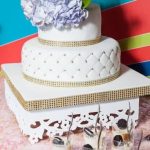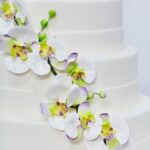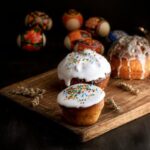Cake decoration plays a crucial role in transforming a simple dessert into an exquisite masterpiece. And when it comes to creating visually stunning and delicious cake decorations, chocolate is undoubtedly a popular choice among bakers and cake enthusiasts. With its smooth and velvety texture, rich flavors, and endless possibilities for creativity, chocolate has become an essential element in cake decoration.
The art of cake decoration goes beyond just making the dessert visually appealing; it adds another layer of excitement and taste to the overall experience. Cake decorations can range from simple designs to intricate chocolate masterpieces that showcase exceptional craftsmanship. Using chocolate as a medium for decorating cakes allows bakers to explore their creativity and create unique combinations of flavor and aesthetics.
Historically, cake decoration has evolved from basic designs to elaborate creations using various techniques and materials. However, none have stood the test of time quite like chocolate. Through different eras, chocolate has been utilized in countless ways to enhance the appearance of cakes, taking them from ordinary to extraordinary.
In the following sections, we will delve into the history of cake decoration with a focus on chocolate’s rise to prominence. We will explore the types of chocolate commonly used in cake decoration and learn about the basic techniques involved.
Additionally, we will look at creative chocolate decorations for cakes that range from delicate shards and curls to indulgent truffles and ganache. Furthermore, we will discover how chocolate can be incorporated into cake designs through layering, filling, and even sculpting.
Whether you are a professional baker or an aspiring home baker looking to elevate your skills in cake decoration, this article is designed to provide valuable insights into working with chocolate as well as inspire you with stunning examples from expert bakers. So grab your apron, gather your ingredients, and let’s embark on a journey where we embrace the artistry of cake decoration with chocolate while experimenting with new techniques along the way.
History of Cake Decoration
The history of cake decoration dates back centuries, with designs evolving from simple patterns to intricate chocolate masterpieces. Cake decoration has always been important as it not only adds aesthetic appeal but also enhances the overall taste and experience of enjoying a slice of cake. Chocolate, in particular, has become a popular choice for decorating cakes due to its versatility and ability to create stunning edible works of art.
Evolution of Cake Decoration
Cake decoration can be traced back to ancient Egypt, where cakes were often topped with fruits and nuts as symbols of harvest and fertility. Over time, cake decorating techniques developed in various cultures around the world. In medieval Europe, elaborate sugar paste decorations became popular among nobility, while simple royal icing designs adorned wedding cakes. As time passed, bakers began experimenting with new materials and techniques, leading to the use of chocolate as a decorative element.
Rise of Chocolate Decorations
The use of chocolate in cake decoration gained significant popularity in the 18th century when cocoa beans started being imported from South America. Initially used as a filling or frosting for cakes, chocolate soon took on a decorative role with the invention of chocolate molds and other tools for shaping it into intricate designs. The Industrial Revolution further fueled the growth of chocolate decorations by making mass production more accessible.
The Artistry of Chocolate Masterpieces
In recent years, cake decorators and chocolatiers have pushed the boundaries of what is possible with chocolate as a medium. Elaborate sculptures, detailed figurines, and stunning showpiece cakes are all made achievable through mastering advanced skills and techniques. From ornate floral patterns to lifelike animal sculptures, these exquisite chocolate creations have transformed cake decoration into an art form that captivates both the eyes and taste buds.
As we delve deeper into the world of cake decoration with chocolate, we will explore different types of chocolates used for decorating, basic techniques for working with chocolate, creative chocolate decorations, and more. Whether you are a professional pastry chef or an aspiring home baker, the history of cake decoration with chocolate serves as an inspiration to push boundaries and ignite creativity in your own sweet creations.
Types of Chocolate Used in Cake Decoration
When it comes to decorating cakes with chocolate, one of the first considerations is the type of chocolate to use. Dark, milk, and white chocolate are the most commonly used varieties in cake decoration. Each type has its own unique characteristics and flavor profiles, allowing bakers and decorators to create a wide range of designs and textures.
Dark chocolate is known for its intense and slightly bitter flavor. It typically contains a higher percentage of cocoa solids compared to milk and white chocolate. This richness makes it an excellent choice for creating intricate decorations such as filigree work and lattice patterns. Dark chocolate can also be used to make velvet-like ganache that can be poured over the cake or used to fill layers.
Milk chocolate, on the other hand, has a sweeter flavor due to the addition of milk solids and sugar. Its smooth texture makes it easy to work with when melting or molding into shapes. Milk chocolate is often favored by decorators who want a more subtle flavor profile in their designs. It is commonly used for making chocolate curls, drizzles, and truffles that add visual appeal to cakes.
White chocolate is made from cocoa butter, sugar, and milk solids but does not contain any cocoa solids. This gives it a milder taste compared to dark or milk chocolate. White chocolate is treasured for its creamy and sweet qualities that lend themselves well to creating elegant decorations like delicate flowers or piped lace. It can also be colored using food coloring gels or melted compound chocolates for more vibrant designs.
Basic Techniques for Decorating Cakes with Chocolate
Chocolate is not only delicious, but it can also be a versatile and beautiful medium for cake decoration. The basic techniques for decorating cakes with chocolate include tempering, piping, and dipping. These techniques allow bakers to create stunning designs and add an extra touch of elegance to their cakes.
One of the most important techniques in working with chocolate is tempering. Tempering is the process of heating and cooling chocolate to specific temperatures in order to stabilize its crystalline structure. This ensures that the chocolate has a smooth texture, glossy appearance, and a pleasant snap when broken. Without proper tempering, the chocolate may appear dull or have a grainy texture.
Piping is another basic technique used for decorating cakes with chocolate. Piping involves using a pastry bag fitted with a small nozzle to create intricate designs or patterns on cakes. Bakers can pipe melted chocolate directly onto the cake or onto wax paper in various shapes and forms, such as flowers, scrolls, or messages. It requires skill and precision to control the flow of the melted chocolate while maintaining steady hands.
Dipping is a simple yet effective technique for adding a touch of elegance to a cake. To achieve this technique, bakers melt chocolate and dip the desired item into it, whether it’s fruits, cookies, or even cake pops. The dipped item is then allowed to cool and harden before being placed on top of or around the cake. Dipped decorations are visually pleasing and can elevate the overall presentation of the cake.
Mastering these basic techniques opens up endless possibilities for creating unique and visually appealing cake decorations using chocolate. Whether it’s creating intricate designs with piped chocolate or adding an elegant touch with dipped decorations, these techniques are essential skills for any baker looking to take their cake decoration game to new heights.
| Technique | Description |
|---|---|
| Tempering | The process of heating and cooling chocolate to stabilize its crystalline structure, resulting in a smooth texture, glossy appearance, and snap when broken. |
| Piping | Using a pastry bag fitted with a small nozzle to create intricate designs or patterns on cakes by piping melted chocolate. |
| Dipping | Melting chocolate and dipping desired items into it, such as fruits or cookies, then allowing them to cool and harden for visually pleasing decorations. |
Creative Chocolate Decorations for Cakes
When it comes to cake decoration with chocolate, there are endless creative possibilities that can elevate the appearance and taste of any cake. From adding delicate chocolate shards and curls to incorporating rich truffles and indulgent ganache, these decorative elements can truly make a cake stand out. In this section, we will explore some of the most popular and visually appealing chocolate decorations that can be used to enhance the beauty and flavor of cakes.
Shards and Curls
One of the simplest yet elegant ways to decorate a cake with chocolate is by creating shards or curls. Chocolate shards are thin, irregularly shaped pieces of chocolate that can be used to create texture and dimension on a cake. These shards can be made by spreading melted chocolate onto a baking sheet, allowing it to harden, and then breaking it into various sizes.
On the other hand, chocolate curls are made by using a vegetable peeler or special tools designed for shaping chocolate. These delicate curls can be arranged in different patterns or piled up for an eye-catching effect.
Truffles
Truffles are small balls of velvety chocolate ganache that can be coated in various toppings such as cocoa powder, chopped nuts, or even more melted chocolate. These decadent treats not only add visual interest but also provide bursts of intense flavor when incorporated into cake decoration. Truffles can be placed strategically around the cake’s edges or arranged in a neat pattern on top. Additionally, they can also serve as individual garnishes on slices of cake.
Ganache
Ganache is a luxurious combination of creamy chocolate and heavy cream that offers versatility in both taste and decoration. It can be poured over the entire surface of a cake for a smooth glaze-like finish or dripped down the sides for a trendy drip effect.
Ganache can also be whipped to achieve lighter textures that are ideal for filling and frosting cakes. Furthermore, ganache can be flavored with various extracts, liqueurs, or even fruit purées to provide a wide range of options for cake decoration.
These creative chocolate decorations are just a few examples of how you can take your cake to the next level. Whether you choose shards and curls for an elegant touch, truffles for bursts of flavor, or ganache for a versatile and smooth finish, incorporating these chocolate elements will undoubtedly make your cake look and taste extraordinary.
So let your imagination run wild as you experiment with different techniques and designs to create stunning cake decorations using the irresistible power of chocolate.
Incorporating Chocolate into Cake Designs
When it comes to cake decoration with chocolate, there are endless possibilities for incorporating this delicious ingredient into your designs. From layering to filling and even sculpting, chocolate can truly elevate the visual appeal of a cake. In this section, we will explore some techniques for incorporating chocolate into cake designs.
One popular way to incorporate chocolate into cake designs is through layering. This involves adding layers of chocolate between the cake layers, creating a rich and indulgent experience with every bite. You can use various types of chocolate, such as dark, milk, or white chocolate, depending on your personal preference and the flavor profile you want to achieve.
Filling a cake with chocolate is another great option for adding depth and flavor to your creation. Whether it’s a ganache filling that oozes decadence or a creamy chocolate mousse that adds a light and airy texture, filling a cake with chocolate can take it to the next level. A tip for successful filling is to make sure the cake layers are level and stable before adding the filling so that it distributes evenly throughout the cake.
Sculpting with chocolate allows for incredible creativity in cake decoration. From molding figures and flowers to creating intricate shapes and textures, sculpting with chocolate can transform an ordinary cake into a work of art. One technique commonly used in sculpting with chocolate is tempering – a process that ensures the chocolate has a smooth and glossy finish with good stability.
Incorporating chocolate into cake designs not only adds flavor but also enhances the visual appeal of your creations. The combination of colors and textures that can be achieved through layering, filling, and sculpting will impress any dessert lover. Experimentation is key in finding unique ways to incorporate chocolate into your cakes, making each creation truly one-of-a-kind. So go ahead and let your imagination run wild – the result will be a beautiful and delicious masterpiece.
- Layering: Adding layers of chocolate between cake layers for a rich and indulgent experience.
- Filling: Incorporating chocolates in fillings such as ganache or chocolate mousse to enhance flavor and texture.
- Sculpting: Molding figures, flowers, or creating intricate shapes using well-tempered chocolate.
Tips for Successful Cake Decoration with Chocolate
Decorating a cake with chocolate can add an extra touch of elegance and indulgence to any celebration. However, working with chocolate can be tricky and mistakes are common, especially for beginners. In order to achieve professional results and avoid common pitfalls, there are several tips and techniques that can be followed.
One important tip for successful cake decoration with chocolate is to make sure the chocolate is properly tempered before using it. Tempering is the process of melting and cooling chocolate to specific temperatures in order to stabilize its cocoa butter crystals. This ensures that the chocolate will have a smooth texture, shiny appearance, and will set properly.
To temper chocolate, it is best to use a double boiler or a microwave in short bursts, stirring frequently. It is also important to use high-quality chocolate for the best results.
Another tip is to practice piping techniques before decorating the actual cake. Piping is the process of creating decorative designs or lettering by squeezing out melted chocolate through a piping bag fitted with a small round tip. It requires control and precision, which can be developed through practice. Before piping on the cake, it is recommended to practice on parchment paper or a silicone mat until comfortable with the technique.
When dipping fruits or other items into melted chocolate for decoration, it is important to make sure they are dry beforehand. Any moisture on the surface of the item can cause the chocolate to seize up and become grainy instead of smooth. To prevent this from happening, it is best to pat dry fruits or other items thoroughly before dipping them into melted chocolate.
| Tips for Successful Cake Decoration with Chocolate |
|---|
| Tip 1: Make sure the chocolate is properly tempered |
| Tip 2: Practice piping techniques before decorating the cake |
| Tip 3: Ensure that fruits or other items to be dipped are thoroughly dried |
Showcasing Stunning Examples of Cake Decoration with Chocolate
Cake decoration with chocolate offers endless possibilities for creating stunning and visually appealing cakes. Expert bakers have honed their skills in using chocolate to transform ordinary cakes into works of edible art. Here are some inspiring ideas from expert bakers that showcase the beauty and versatility of cake decoration with chocolate:
- Chocolate Shards: One popular technique is creating delicate and elegant chocolate shards to adorn the top of a cake. To make these, melted chocolate is spread thinly on a non-stick surface and allowed to set partially before being scored or broken into irregular pieces. These shards can be arranged in various patterns or used as borders, adding a touch of sophistication to any cake.
- Chocolate Curls: Chocolate curls are another classic way to decorate cakes with chocolate. They can be made by gently drawing a vegetable peeler across a block of solid tempered chocolate, resulting in beautiful, curved strips of chocolate that can be arranged in clusters or spirals on top of the cake.
- Chocolate Truffles: For an indulgent touch, expert bakers often incorporate chocolate truffles into their cake decorations. These bite-sized confections can be made with different flavored fillings and coated in tempered chocolate before being arranged on top of the cake. Not only do they provide fabulous texture, but they also add an extra layer of flavor that complements the cake itself.
- Chocolate Ganache: Ganache is a rich and velvety mixture created by combining heated cream with finely chopped chocolates. It serves as both a filling and frosting for cakes and can be poured over the top to create a smooth glaze effect or piped onto the sides to create intricate designs. Expert bakers often experiment with different flavors and consistencies of ganache to add depth and dimension to their creations.
These are just a few stunning examples of how expert bakers use chocolate to elevate their cake decoration game. The key takeaway from these examples is that creativity knows no bounds when it comes to cake decoration with chocolate.
Whether it’s using shards and curls or incorporating truffles and ganache, the possibilities are truly endless. By experimenting with different techniques and designs, aspiring bakers can create their own unique masterpieces that will delight both the eyes and the taste buds.
Conclusion
Cake decoration with chocolate is not just a culinary art, but it is also a way to create visually stunning masterpieces that delight both the eyes and the taste buds. Throughout history, cake decoration has evolved from simple designs to elaborate chocolate creations that showcase immense skill and creativity.
In this article, we have explored the types of chocolate used in cake decoration, discussed basic techniques for decorating cakes with chocolate, and showcased stunning examples of cake decoration using various chocolate elements.
The versatility of chocolate in cake decoration cannot be overstated. Whether it’s dark, milk, or white chocolate, each type brings its own unique flavor and aesthetic appeal to the final creation.
From tempering and piping to dipping and molding, the techniques used in working with chocolate require precision and attention to detail. By mastering these basic techniques, one can create an array of creative decorations such as shards, curls, truffles, and ganache that elevate the overall presentation of the cake.
Incorporating chocolate into cake designs goes beyond mere garnishing; it becomes an integral part of the structure and flavor profile of the cake. Layering different types of chocolates adds depth and richness to every bite, while filling cakes with creamy ganache or sculpting intricate shapes out of molded chocolate takes the artistry to new heights. Successful cake decoration with chocolate requires patience, practice, and a keen eye for aesthetics.
By embracing the art of cake decoration with chocolate and experimenting with new techniques, bakers can push their creative boundaries and leave a lasting impression on their customers and guests. The possibilities are endless when it comes to combining different flavors, textures, colors, and shapes with chocolate to create edible works of art that are as delicious as they are visually stunning.
So whether you are a professional baker looking to expand your repertoire or a home baker eager to impress your loved ones with a beautifully decorated cake adorned with decadent chocolate creations – embrace this delightful journey into the world where pastry meets art. With chocolate as your canvas and imagination as your guide, the possibilities are truly endless. Happy decorating.
Frequently Asked Questions
How to decorate a cake with chocolate pieces?
Decorating a cake with chocolate pieces can add a touch of elegance and flavor to your creation. Start by selecting high-quality chocolate bars that are suitable for melting, such as dark, milk, or white chocolate. Once you have your choice of chocolate ready, melt it using a double boiler or microwave until smooth and glossy. Next, pour the melted chocolate into a piping bag fitted with a small round tip or a Ziploc bag with a tiny corner snipped off.
Begin by creating simple designs like swirls, lines, or dots on parchment paper, allowing them to set in the fridge until firm. Once hardened, carefully peel them off and arrange them creatively on your cake’s frosting or ganache. Additionally, you can consider using chocolate shavings or curls to create borders around the cake layers or even cover the entire surface for a beautiful and tasty finishing touch.
How to make chocolate decorations for top of cake?
Making chocolate decorations for the top of a cake is an excellent way to add a stunning centerpiece that will impress your guests. You can start by tempering your preferred type of chocolate – dark, milk, or white – which involves melting it gently and then cooling it down slightly until smooth and slightly glossy while retaining its structure at room temperature. Once tempered, pour the melted chocolate into molds designed specifically for creating decorative shapes such as flowers, leaves, hearts, stars, or any other desired design.
Smooth out any excess using an offset spatula before refrigerating until firm. Carefully remove the set shapes from the molds onto a clean surface and let them come back to room temperature before placing them on top of your frosted cake.
What to put on chocolate cake for decoration?
When it comes to decorating a chocolate cake, there are countless options available depending on personal preferences and creativity. Some delicious suggestions include whipped cream rosettes piped along the edges or in between layers of the cake for an elegant yet simple touch. Fresh fruits like strawberries or raspberries make fantastic toppings with their vibrant colors and natural sweetness. Dusting the cake with powdered sugar or cocoa powder can create a classic and minimalistic appearance, while edible flowers provide a touch of natural beauty.
Another idea is to use chocolate ganache to create beautiful drips along the sides of the cake or to pour over the top for a glossy finish. Other popular options include crushed nuts, sprinkles, chocolate shavings, or even writing personalized messages with icing. Ultimately, choose decorations that complement the rich flavor of the chocolate cake while adding visual appeal to make it a centerpiece for any occasion.

Welcome to my blog about home and family. This blog is a place where I will share my thoughts, ideas, and experiences related to these important topics. I am a stay-at-home mom with two young children. I hope you enjoy reading it! and may find some helpful tips and ideas that will make your home and family life even better!





